Typhoid Treatment Market Research, 2032
The global typhoid treatment market size was valued at $2.9 billion in 2022, and is projected to reach $4.8 billion by 2032, growing at a CAGR of 5.1% from 2023 to 2032. Typhoid treatment refers to the medical interventions and therapies aimed at managing and curing typhoid fever, a serious and potentially life-threatening infectious disease caused by the bacterium Salmonella enterica serovar typhi. The disease is primarily transmitted through contaminated food and water, making it a significant public health concern, especially in regions with inadequate sanitation and limited access to clean drinking water.
The primary approach to typhoid treatment involves the administration of antibiotics to target and eliminate the Salmonella bacteria responsible for the infection. Commonly used antibiotics include fluoroquinolones, cephalosporins, and azithromycin. The timely and appropriate use of antibiotics is crucial in reducing the severity and duration of the illness, as well as preventing complications. In addition to antibiotics, supportive care plays a vital role in typhoid treatment. Adequate hydration, rest, and a balanced diet are essential in helping the body combat the infection and recover from the associated symptoms, such as high fever, gastrointestinal disturbances, and weakness
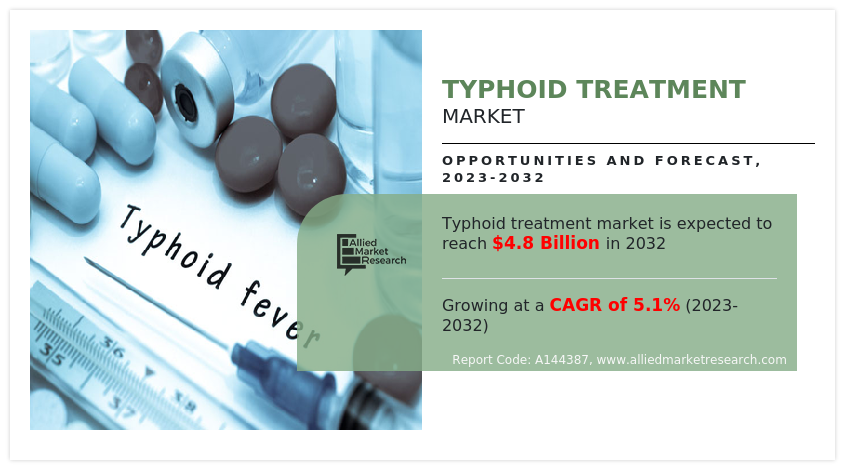
Market Dynamics
The typhoid treatment market share is driven by several factors including a high incidence of typhoid infections, rise in antibiotic resistance, and growing government initiatives for awareness regarding typhoid diagnosis and treatment
Typhoid fever remains a significant global health concern, particularly in regions with limited access to clean water and proper sanitation. The high incidence of typhoid infections drives the demand for effective treatment options. According to an article published by Medscape in 2022, typhoid fever infected approximately 21.6 million people globally, with an incidence rate of 3.6 per 1,000 population. Furthermore, it causes an estimated 200,000 deaths annually. The prevalence of the disease necessitates a continuous need for treatment, thus fueling the growth of the typhoid treatment market size.
In addition, the emergence of antibiotic-resistant strains of Salmonella typhi, is a growing concern in the medical community. Conventional antibiotics that were once effective in treating typhoid are becoming less potent due to bacterial resistance. This creates a demand for new and innovative treatment options to combat drug-resistant strains. Pharmaceutical companies are investing in R&D efforts to discover novel drugs and therapeutic approaches, thus driving advancements in the typhoid treatment market share.
Moreover, increase in global travel and rise in urbanization contribute to the spread of infectious diseases, including typhoid fever. People traveling across borders can unknowingly carry the Salmonella typhi bacteria, introducing it to new regions and contributing to the transmission of the disease. For instance, according to an article published in Elsevier 2021, about 200–300 cases of the infection were reported in the U.S. each year and 80% of which occur in travelers returning from countries where typhoid fever is endemic. Moreover, rapid urbanization has led to overcrowded urban centers with inadequate sanitation and limited access to clean water, creating conducive environments for typhoid transmission. These factors drive the need for effective typhoid treatments to address the growing disease prevalence in urban areas.
Furthermore, various governments and international organizations are recognizing the impact of typhoid on public health and are taking proactive measures to control the disease. Initiatives may include vaccination campaigns, improved healthcare infrastructure, and increased funding for research and treatment development. These efforts drive market growth by promoting early diagnosis, access to healthcare, and better treatment outcomes.
However, antibiotic resistance poses a growing threat, limiting the efficacy of conventional treatments. Stringent regulatory requirements can delay new treatment approvals, thus impacting market growth. Adverse effects and safety concerns with certain antibiotics also affect patient compliance. Furthermore, a lack of awareness about early diagnosis and treatment hampers timely intervention. Addressing these challenges necessitates innovative approaches, including the development of alternative treatments, public health awareness campaigns, and improved diagnostic tools to foster effective management of typhoid and drive market growth.
What is the Impact of 2023 Recession on Typhoid Treatment Market?
The recession can present challenges for the typhoid treatment market, particularly for pharmaceutical companies engaged in R&D efforts. During economic downturns, funding constraints and reduced return on investment in pharma R&D may impede the progress of introducing new and innovative typhoid treatments to the market. For instance, Deloitte's report in January 2023 showed that the projected return on investment in pharma R&D fell to 1.2%, the lowest in 13 years. In addition, the average cost of developing a new drug rose significantly, reaching $2.3 billion in 2022. This financial pressure may lead to slower development timelines and reduced focus on researching new treatments for typhoid and drug resistant typhoid.
However, large pharmaceutical companies often possess vast and valuable databases accumulated over years of drug discovery efforts. These databases contain extensive information on various compounds, their properties, and their interactions with biological targets. Access to such data can significantly reduce the time and resources required to identify potential molecules for typhoid treatment.
Moreover, amidst these challenges, the recession has also sparked a greater focus on cost-effective and accessible solutions for typhoid treatment. This has led to an increase in demand for generic drugs, lower-cost vaccines, and improved healthcare infrastructure in regions, which are heavily affected by typhoid. The market has witnessed collaborations between pharmaceutical companies, non-profit organizations, and government bodies to address the affordability and availability of treatments.
Segmental Overview
The typhoid treatment market is segmented on the basis of treatment type, route of administration, distribution channel, and region. On the basis of treatment type, the market is classified into antibiotics, pain medication and others. The antibiotics segment is bifurcated‐¯into fluoroquinolones, macrolides, cephalosporins, and others. On the basis of route of administration; the market is divided into oral and intravenous. Depending on distribution channel, it is categorized into hospital pharmacies, drug stores and retail pharmacies, and online providers. Region-wise, the market is analyzed across North America (U.S., Canada, and Mexico), Europe (Germany, France, UK, Italy, Spain, and Rest of Europe), Asia-Pacific (Japan, China, Australia, India, South Korea, and Rest of Asia-Pacific), and LAMEA (Brazil, South Africa, Saudi Arabia, and Rest of LAMEA).‐¯
By Treatment Type:
The typhoid treatment market is segmented into antibiotics, pain medication and others. The antibiotics segment held the highest market share in terms of revenue in 2022 and is expected to maintain its dominance during the forecast period, owing to rise in governments and regulatory bodies initiatives to control and manage infectious diseases, further driving the adoption of antibiotics in various healthcare settings. In addition, the ongoing R&D efforts by pharmaceutical companies to discover novel antibiotics and improve existing ones are expected to result in the introduction of more effective and targeted treatments, thus bolstering the dominance of the antibiotics segment in the market. Furthermore, the global efforts to combat infectious diseases, is expected to fuel the growth of the antibiotics segment.
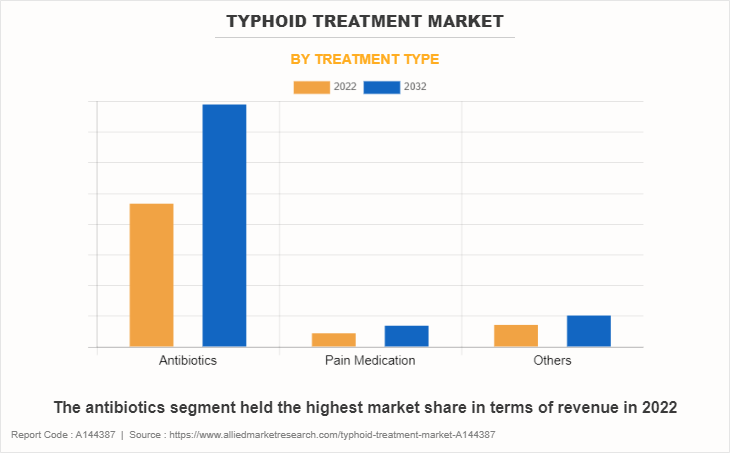
By Route of Administration:
The typhoid treatment market is divided into oral and intravenous. The intravenous segment held the highest market share in terms of revenue in 2022 and is expected to maintain its dominance during the forecast period, owing to the significant expenses associated with intravenous medications and its crucial function in providing quick and efficient medical therapies. Intravenous administration entails the direct introduction of fluids, drugs, and essential nutrients into the bloodstream, ensuring swift absorption and instant therapeutic effects. This approach holds particular importance during urgent medical scenarios and for individuals with serious ailments necessitating rapid medical intervention.
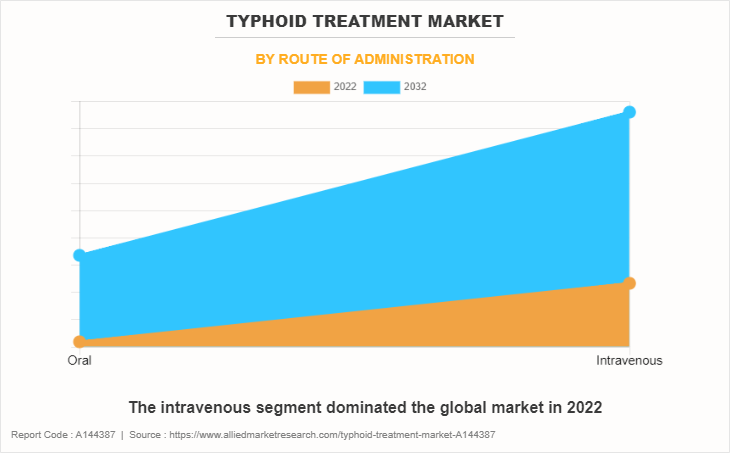
By Distribution Channel:
The typhoid treatment market is classified hospital pharmacies, drug stores and retail pharmacies, and online providers. The hospital pharmacies segment dominated the typhoid treatment industry in terms of revenue in 2022, owing to its pivotal role as a primary distribution channel for pharmaceutical products and treatments. Hospital pharmacies serve as key points of access for medications, including antibiotics and supportive therapies, which are crucial in managing typhoid fever effectively.‐¯‐¯
However, online providers segment is projected to exhibit the highest CAGR in the typhoid treatment market during the forecast period, owing to the convenience in shopping, increase in e-commerce sales, improvements in logistics services, and ease in payment options. In addition, the easy accessibility and heavy discounts & offer provided by these online platforms drives the growth of online pharmacies during typhoid treatment market forecast period.‐¯
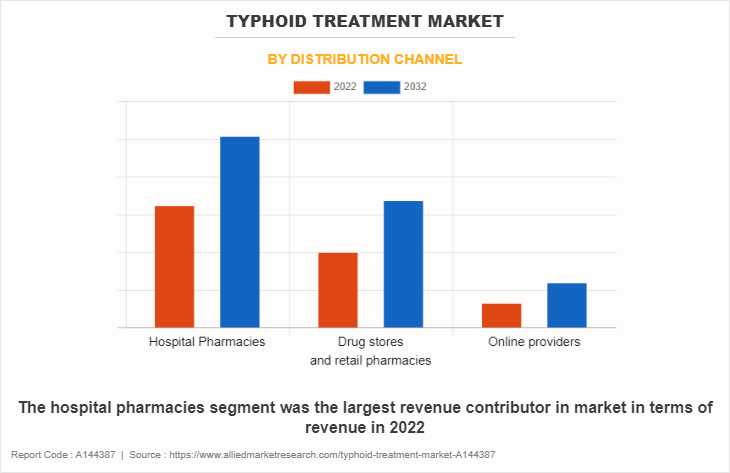
By Region:
The typhoid treatment market is analyzed across North America, Europe, Asia-Pacific, and LAMEA. North America held the highest market share in terms of revenue in 2022 and is expected to maintain its dominance during the forecast period, owing to increase in incidence of infectious bacterial diseases and presence of guidelines for optimizing the use of antibiotics. In addition, the presence of key market players and their offerings strengthens the market position. These companies actively engage in R&D activities, ensuring the availability of innovative and effective treatment for typhoid. Moreover, the limitations of antibiotics in treatment of typhoid fever is anticipated to drive investment and collaborations between key players, which is expected to contribute to the market growth during the forecast period.
However, the Asia-Pacific region is projected to exhibit the highest CAGR in the typhoid treatment industry during the forecast period. This growth can be attributed to several factors including high incidence of typhoid, rapid population growth, and increase in urbanization. Also, the improving healthcare infrastructure and increased initiatives in awareness and support for early diagnosis and treatment are anticipated to drive market growth in the region.
Moreover, the rise in research activities as well as the well-established presence of domestic companies in the region are expected to provide notable opportunities for market growth. In addition, rise in contract manufacturing organizations within the region is expected to drive the typhoid treatment market growth.
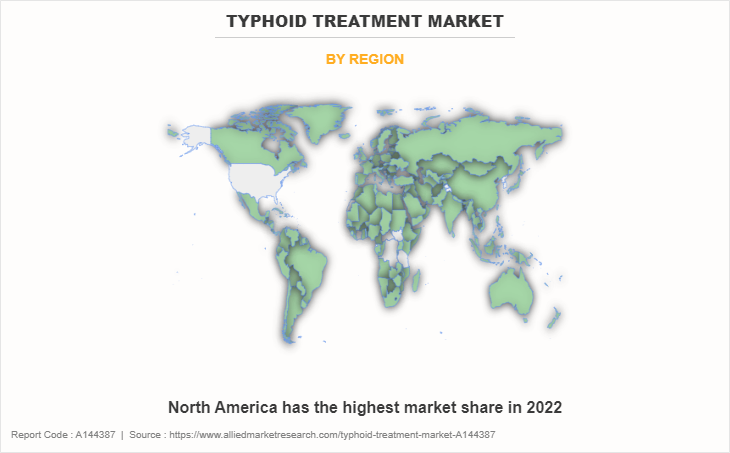
Competition Analysis
Competitive analysis and profiles of the major players that operate in the market include Abbott Laboratories, Alkem Laboratories Ltd., Cipla Ltd, Bayer AG, Lupin Limited , Novartis AG, Pfizer Inc., Sun Pharmaceutical Industries Limited, F. Hoffmann-La Roche Ltd. and Teva Pharmaceutical Industries Limited are provided in the report. Key players have adopted strategy such as funding to enhance their product portfolio.
Recent Funding in Typhoid Treatment Market
In October 2021, Teva Pharmaceutical Industries Limited, a global leader in generic and specialty medicines and more than 20 other pharmaceutical companies, launched the antimicrobial resistance (AMR )Action Fund that aims to bring two to four new antibiotics to patients by 2030. The Fund will invest $1 billion and provide expertise to help antibiotics through the development process.
Key Benefits For Stakeholders
- This report provides a quantitative analysis of the market segments, current trends, estimations, and dynamics of the typhoid treatment market analysis from 2022 to 2032 to identify the prevailing typhoid treatment market opportunity.
- The market research is offered along with information related to key drivers, restraints, and opportunities.
- Porter's five forces analysis highlights the potency of buyers and suppliers to enable stakeholders make profit-oriented business decisions and strengthen their supplier-buyer network.
- In-depth analysis of the typhoid treatment market segmentation assists to determine the prevailing market opportunities.
- Major countries in each region are mapped according to their revenue contribution to the global market.
- Market player positioning facilitates benchmarking and provides a clear understanding of the present position of the market players.
- The report includes the analysis of the regional as well as global typhoid treatment market trends, key players, market segments, application areas, and market growth strategies.
Typhoid Treatment Market Report Highlights
| Aspects | Details |
| Market Size By 2032 | USD 4.8 billion |
| Growth Rate | CAGR of 5.1% |
| Forecast period | 2022 - 2032 |
| Report Pages | 250 |
| By Treatment type |
|
| By Route of Administration |
|
| By Distribution Channel |
|
| By Region |
|
| Key Market Players | Novartis AG, F. Hoffmann-La Roche Ltd., Alkem Laboratories Ltd., Cipla Ltd., Lupin, Pfizer Inc., SUN PHARMACEUTICAL INDUSTRIES LIMITED, Abbott Laboratories, Bayer AG, Teva Pharmaceutical Industries Limited |
Analyst Review
According to the insights of CXOs, the typhoid treatment market presents several opportunities and challenges. The growing prevalence of typhoid infectious globally remains a key driver. Thus, the demand for effective antibiotics continues to rise, providing opportunities for market expansion.
CXOs further stated that the expanding global population, particularly the aging demographics, contributes to the rise in demand for effective treatments, as they are susceptible to typhoid infections. Moreover, growing initiative by pharma companies to enhance antibiotics R&D and technological innovations in antibiotics significantly boost the growth of the typhoid treatment market. However, development of antibiotic resistance, driven by misuse of antibiotics and increase in drug approval costs, are expected to hinder the market growth. In addition, improved healthcare infrastructure, especially in developing regions, enhances access to diagnosis and treatment, thus contributing to the growing demand for antibiotics for the treatment of typhoid infection.
Furthermore, several factors contribute to the growth of the typhoid treatment market in the North America region. Increase in prevalence of bacterial infections and rise in burden of antimicrobial resistance drive the demand for effective antibiotics use for typhoid treatment in the market. Furthermore, Asia-Pacific is anticipated to witness notable growth during the forecast period, owing to rise in antimicrobial resistance, which leads pharmaceutical companies toward R&D for next generation antibiotics. Also, lack of sanitization practices in particular regions further drive the market growth.
Typhoid treatment refers to the medical interventions and therapies aimed at managing and curing typhoid fever. It involves the administration of antibiotics, such as fluoroquinolones or cephalosporins, to eliminate the bacteria and alleviate symptoms such as fever, gastrointestinal disturbances, and weakness.
The base year is 2022 in typhoid treatment market.
The estimated market value of the typhoid treatment market is $2,898.64 million in 2022.
The forecast period for typhoid treatment market is 2023 to 2032.
The market value of the typhoid treatment market in 2032 is $4,789.88 million.
The upcoming trends of Typhoid Treatment Market in the world are rise in the prevalence of typhoid infection, availability of generic antibiotics and the rise in R&D activities
The antibiotics segment is the leading segment in typhoid treatment market owing to the rise in government and regulatory bodies initiatives to control and manage infectious diseases, thus, further driving the adoption of antibiotics in various healthcare settings.
North America is the largest regional market for Typhoid Treatment.
Top companies such as Pfizer Inc., Bayer AG, F. Hoffmann-La Roche Ltd. and Cipla Ltd. held a high market position in 2022. These key players held a high market position owing to the strong geographical foothold in North America, Europe, Asia-Pacific, and LAMEA.
Loading Table Of Content...
Loading Research Methodology...



